Story by Christopher Hector & Photos by Roslyn Neave
Sue Hearn is a model for all our aspiring dressage riders, here is a rider who sits quietly, correctly in balance, on a horse that flows rhythmically and demonstrates that it is possible to actually improve the natural paces as the horse’s education progresses.
When you watch educated riders it is easy to see what they are doing, and what they are aiming to achieve. Watching Sue work on her Grand Prix horse, Remmington, is a reminder of that: everything fits together, there’s no spurring or jerking… After the session I remark to Sue that, riders go out of their way to complicate what is essentially a rather simple process…
“Yes, I think if the horse feels good in the back and good in the contact, then that’s your main ingredient isn’t it? And basic exercises. I trained with Miguel Tavora for a very long time, and he has some fabulous ways of getting the horse’s back relaxed. I am not a big believer in pushing and holding, because I can’t hold them eventually. That’s my big thing, I want to be able to ride and not have to use my muscles to hold the horse. I want the horse to respond to half halts and relax and hopefully build himself.”
Sue and Remmington winning the Grand Prix at the 2014 Brisbane CDI
Photo: Downunder Photography
I found that when I used to ride with Miguel, he did have so many exercises and variations on movements, then you could spend the next two months riding by yourself, because you had all these little tools.
“He gives you the tools to work through things. Even though I have been to a lot of trainers, and you get something from everybody, but if I have a problem, I always end up going back to the basic exercises to fix the problem, not just go repeat, repeat… those exercises still work for me.”
It sounds so easy, once you get the contact, but it seems to me that about three quarters of the riders doing Grand Prix in Australia don’t have a good contact. How do you establish that lovely sweet connection with your horse’s mouth?
Well, that starts when they are young. You have to be meticulous about that. I really don’t want a horse that’s leaning somewhere or holding somewhere. So that’s my first priority when I’m warming up. You’ll notice with Remmington when I was warming up, he will try and hold me a little bit on the left and I want to break that contact up and get him a little more on the right rein with a little counter-bending. Various times he will hit that again, that’s what he does, every horse has one side or another that they hold. If he does that, then I go back and go bending again. It’s not a big deal, but you’ve got to be meticulous and feel it. And not go, ‘Oh that will do!’ It won’t, it makes everything else half-hearted.” 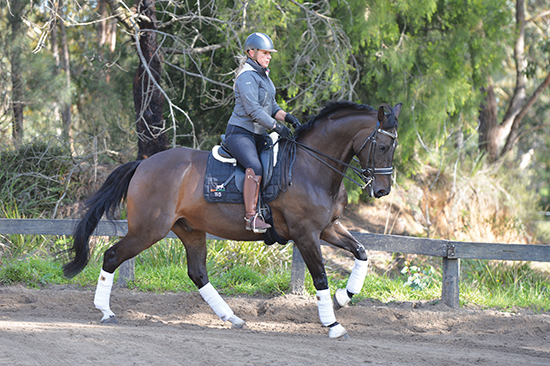
Does he always remain as relaxed as that?
“No, he will come up when he is worried and tightens through the back and then I don’t have him up to the contact and it’s usually the competitions that do that to him. So he takes quite a bit of relaxation work to get him into the ring. We have done now almost two years of competition at Grand Prix and I feel like now, I can actually ride him a little more and not sook him around if that makes sense. You know, now if he get’s worried, I feel like I can say, ‘Come on let’s get on with this, you know what you’re doing’, whereas before he got a bit worried, if you pushed him, he would worry more. We are basically getting the confidence in the test and in the big arena and I feel like we are getting there.”
I think, what I first noticed about him, and again it was glaringly different from a lot of Grand Prix horses going around, was that he still had three pure paces…
“Well, I admire people who can make the really flash trots, but I always find when I start doing that I end up with a horse on my hand and I don’t enjoy that. I want him to get stronger and start to work over the back without too much pressure. I want to give pressure, but not so much that he worries about it. I think a worried horse in the arena is much worse. Everybody has got their way of doing it, I just can’t do it that way.”
How did you get into this dressage thing?
How I got into dressage? I have been doing it for a really long time, which is scary… My first FEI horse was a racehorse that broke down on the track and was given to me. I love training, so the competition is less important than the training to me. I come out here every day; I don’t need a show to go to. I love training them to Grand Prix and it doesn’t matter what horse. I enjoy what that horse can give me. So I have had a few horses that have not been as good at Grand Prix, they can do it, but they are not big scorers. And that’s fine, because I have enjoyed the work. I mean, it would be lovely to have the money to go and buy a really flash one, but I am enjoying what I’m doing. Everybody is a bit different, aren’t they?”
That’s sounds a little easy, ‘I got a broken down one off the track and I made it to Grand Prix’, I mean there’s just a little in between, it’s quite a long process. Who helped you with the first horse and where did you get the crazy idea of doing it?
“When I first started, and this is quite funny and Miguel will remember this, I went to him with my pony club horse which was doing a little bit of this and a little bit of that, prelim to novice level. And Miguel said to me, ‘You are quite a talented rider, you will need a better horse.’ I said, ‘I can’t afford another horse, Miguel, this is it.’ We got that horse through to medium level, I think, but just locally. Then I had a Thoroughbred given to me, Texas, the one that was a bit broken down, and Miguel helped me to get it to the Grand Prix movements. But as he hit Grand Prix, all the things that were broken down from racing started to come through and we retired him. At that stage I had Manhattan, again given to me, and he was two years old.”
So he hadn’t raced?
“No, he was huge. He was way too big to race. I went from training and competing Grand Prix to circle work again with Manhattan. Again I was working with Miguel, because he wasn’t an easy horse, and I had his brother as well that we got going at the same time. We got both those horses through and I needed money and we sold the brother, Chaos. He was doing Prix St Georges and Inter I quite well, and training Grand Prix. He went to Korea, it was sad, but he bought my stable block… Miguel was there through all of that – and they were very ordinary horses.”
Sue and Manhattan
I think that’s unkind to Manhattan. He certainly had a lot of charisma.
He did, he really did. But if you had seen him as a two-year-old, you wouldn’t have bothered.
You have gone to Warmbloods now with Lloyd (Remmington), but it is a Warmblood with an awful lot of Thoroughbred in it, he’s out of Manhattan’s mother.
“Basically, he is a Thoroughbred to ride, again. I think that’s what I enjoy. I had Duntroon in between, who was full Warmblood and very, very talented, but he always made me push him along, which, when you get into the arena, is not easy. Quite good here, but take him into the arena and he gets behind you. Nice horse though. It was a big learning curve for me, he did some really good stuff, but that sort of Warmblood doesn’t suit me; I really don’t want to push them along. Whereas Lloyd, he is just hot and he is keen to do it. He won’t back off or get tired, I think that makes a good Grand Prix horse.”
How ambitious are you with him?
“With him I am as ambitious as he will allow. He is now on the High Performance Squad, so that’s really good. That was a great achievement. Now I am hoping that this season we can push the scores up again, because he’s been on averages of 66.5, last season, so I am hoping we can push that up a little bit and just keep pushing, he’s only eleven. So I am thinking two years maybe, we will be a contender. I am hoping!”
Two years, I think there’s a big show somewhere in Brazil…
Yes, somewhere like that would be nice, but he is what he is, I don’t have expectations, but you never know what could happen on the way.
You were saying that he is a horse that really needs to relax at an event. I guess there will be a lot people who will be reading this and saying, ‘Yes, that’s what my horse does.’ Do you have a favourite exercise or favourite set of routines that you find works for you at a show to get that relaxation back?
“I stick with what I do at home, that’s what I do at a show. I don’t try anything new. I don’t try anything that he thinks is unusual. If he is very tight, I will work on the shoulder-in on the circle, rising trot, to really get him stretching through the back.”
That’s a Miguel one isn’t it?
“It’s fabulous! Really, I saw Carl Hester do a similar thing, but he is using it in leg yielding. It’s all the same thing, it’s just a different way of doing it. My big thing is, you shouldn’t do something different, if you have a routine at home, you should stick to it when you go to a show. And with Remmington, I will try to ride him before the test as well, just to feel how he is and then I don’t have to have a long warm-up or anything like that, which I think is not very good either. Just a short, easy warm-up before the test. We do have a tendency to arrive at a show early.”
Remmington has a spectacular piaffe-passage tour. You were saying that you like to start that quite early with them?
“Because I have had the horses from the beginning, all of them from breaking in – I don’t buy horses that somebody else has done anything with them – I always train them to come back and go forward, come back and go forward and that’s really just the basic piaffe-passage. Often they might offer you a bit more and that’s fine, you don’t really ask them for it until they offer it. They do it happily, it’s not a big deal to come back and trot on the spot a little bit and go forward again.”
So even when they are four or five you play with that?
“Play with it, but no whips or anything, you are not asking. You come back a little bit and go forward again.”
You were saying in the arena, that you like to move him around in the piaffe, and get him manoeuvrable…
“That’s important, in particular for him, because he needs to allow me to move the neck here or move his body there. I don’t want him just to sit in a block, and that relaxes him as well. So that when you are somewhere, you can say, ‘I want your neck a little bit lower, can you go lower in the piaffe?’ And he is happily doing that now, that works for him. Some horses you may not need to, but I do need to do that with him.”
So who is helping you these days?
“I would love to go back to Miguel. I haven’t been back to anybody recently. Mostly because it costs a lot of money and I am madly trying to earn enough money to compete. It’s a very expensive exercise. So nobody really, lately.”
Don’t you get some financing now that you are on the elite squad for instruction?
“No idea, I’ve only just been put on. I was on the elite squad for ten years with Manhattan, and yes, you did get some funding. But I haven’t been on the squad for ages, I don’t know how it works, I’m sure I’ll find out.”
What you were saying before, about when you went over to work with Kyra (Kyrklund) and Richard (White)?
“That was ten years ago, maybe, and I would look at a photo of myself or a video, and I’d think, horse is looking fine, beautiful, and I look like a ‘bag of poo’ up there. Position was never touched on, as long as the horse was doing okay. It didn’t matter, or maybe it did matter, but it wasn’t as important as maybe it should have been. When I went over there, I actually mentioned it to Richard and Kyra, and as soon as I mentioned it, that was focus, it was fantastic. I said, I don’t mind if I don’t do anything else. Richard changed my position around, and Kyra too. We were all told to hold a bit with the knees, and keep the lower leg back – well they were the opposite. It was like, leg goes there, bring the leg forward, straighten up.”
Straighten up your back?
“Yes, straighten up and it was a big thing for me, because they did spend a long time on it. It really sunk in for me. My pupils go, ‘here she comes, the position-Nazi’. You know, you have to be able to sit there, I don’t care what your horse is doing at the moment, don’t get pulled out of balance.”
This article first appeared in the September 2014 issue of THM.




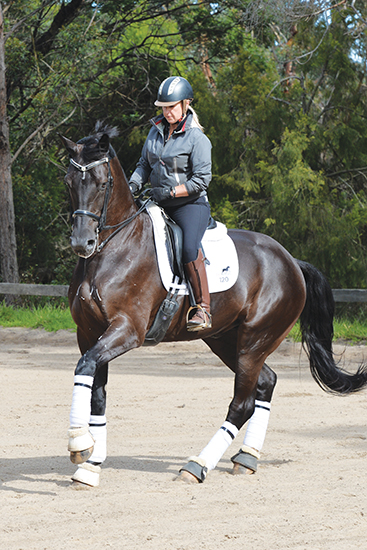
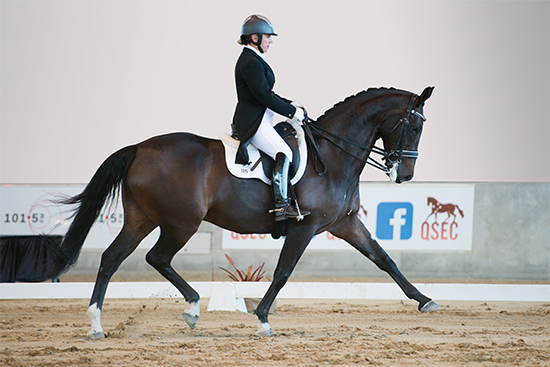

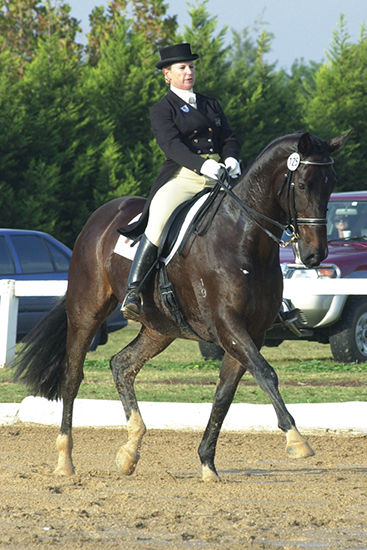
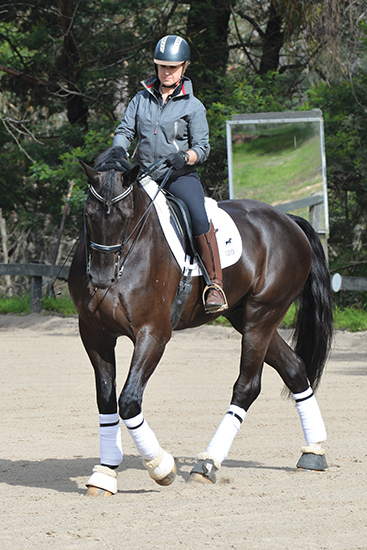
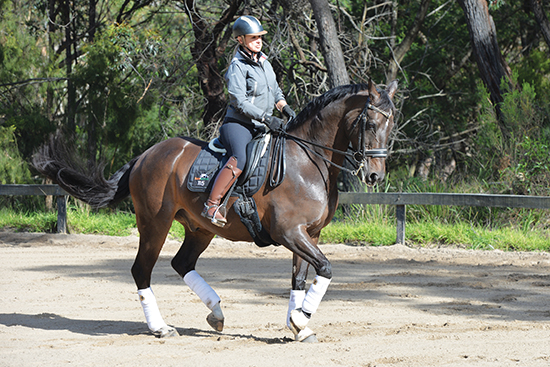
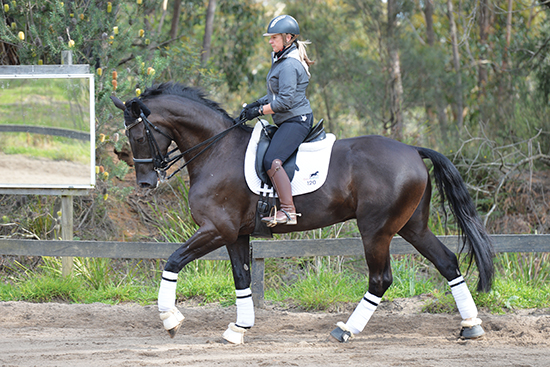
Horses should never be btv PERIOD